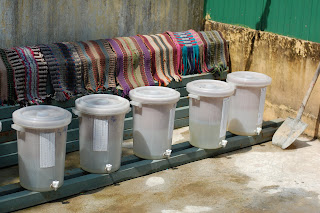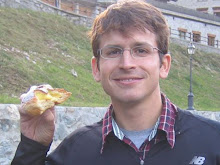Monday was my first day on the project.
Was picked up at my hotel by Pisith (now the HR officer) and Savuen (the new Logistics officer) and taken to the IDE office just outside of what I glean to be the ring road of Phnom Penh. These aren't great shots, but here's two pics of the office--it's more a big house behind a gate. Savath (the R&D tech assigned to this project) had collected a few samples of local latrines. These were all pour-flush pans and were sitting in a courtyard outside the IDE office:

ceramic pour-flush pan embedded in a tiled concrete slab--$17

side view of ceramic pour-flush pan embedded in plain concrete slab--$10

concrete pour-flush pan embedded in plain concrete slab--$6.50
Most of the day was spent talking with Mike Roberts (the Cambodia country director for IDE) and Dan Salter (a former regional director for IDE who’s now acting as the marketing consultant for this sanitation project). In parallel with the product development portion which I’ll be spearheading, Dan’s working on the marketing and sales effort. I’ll get more into that later on when I understand it better, but I did want to share some pics from a trip Savath and I took to a ring-producer. These businesses are pretty common throughout the country (and take on a few variations), but they’re typically the ones that produce the concrete rings which are stacked upon each other to line the inside of a latrine pit. It’s not a huge business, however, so these same guys also use similar technique to make concrete pipes of many different diameters to serve irrigation, drinking and waste water needs:

smaller diameter pipes (0.3m), some in molds

close-up of mold

1m dia x 0.5m tall rings--these are stacked to line a latrine pit and weight 80kg each!!
couldn't quite understand if they're reinforced with mesh or just vertical rebar

stacked rings mortared together--the sealing is not always done,
especially when seepage is intended
This particular producer also manufactured concrete slabs with embedded pans (see above).
The porcelain pans all come from Thailand or China and are cast (upside down) into the slab.
When tiles are used, they’re also cast into the slab in the same step.

mold for casting the pans into the concrete
(not shown is the angle iron sides of the mold)
And lastly, IDE has had great success here in Cambodia with another product: the Rabbit water purifier. In Khmer culture, the rabbit is considered a clever animal, hence the branding. . . It's a gravity-fed ceramic filter that sits in a bucket with a spout. It's quite effective in filtering 'bugs' out of water, but because of the clays used, it adds arsenic to the water. As I understand it, they have to flush 500 bucket-fulls of water through each product before selling in order to eliminate the arsenic. Though I hope I'm wrong. . .

decal on IDE truck

testing of purifiers

the Bugs Bunny-ish rabbit














Hi, sorry for the crazy comment but I used to know Dan Salter a long time ago when I worked in Viet Nam in 1999 and I am wondering if you know how I can reach him? Thanks, Rebeca
ReplyDelete